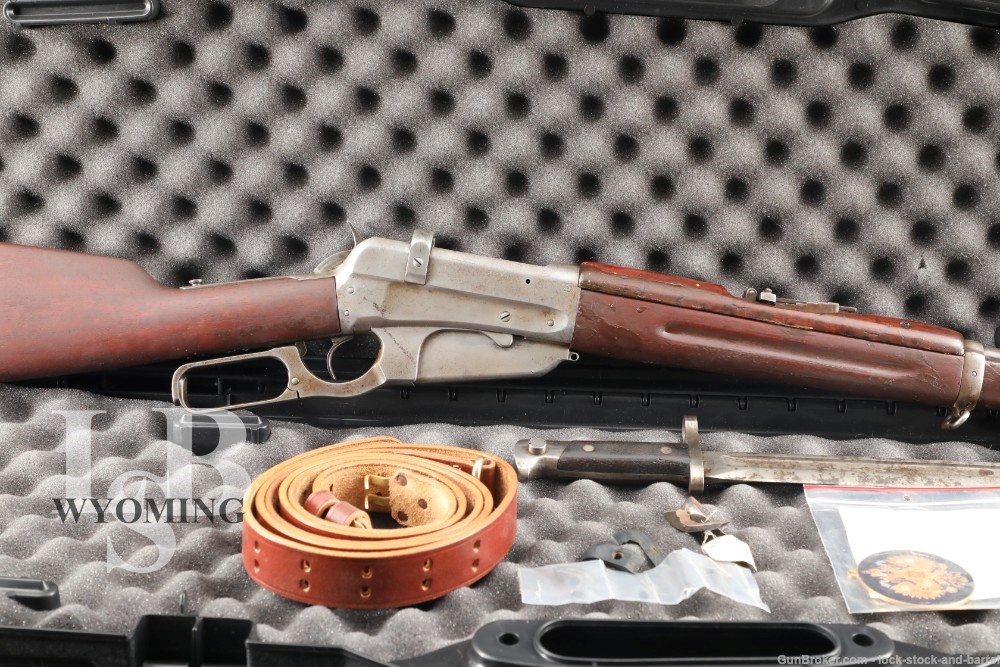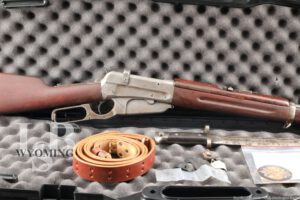
WWI Winchester 1895 Musket Russian Contract 7.62x54R Lever Rifle, 1916 C&R
SOLD FOR: $4,525.00
WOA# WY240608JW003
Make: Winchester
Model: 1895, Russian Contract
Serial Number: 194314
Year of Manufacture: Ca. 1916
Caliber: 7.62x54R
Action Type: Lever Action Rifle with Fixed Box Magazine
Markings: We did not remove the handguard to prevent damage. The Winchester Proof mark is on top of the frame. The top of the receiver ring is also marked “7.62 / M.M.” The left side of the frame is marked “MANUFACTURED BY THE WINCHESTER REPEATING ARMS CO. NEW HAVEN, CONN. U.S.A. / PATENTED NOV. 5. 95. NOV. 12. 95. AUG. 17. 97. JAN. 25. 98. AUG. 23. 98. AUG. 6. 1907.”. The serial number is found on the lower tang over “B”. The upper tang is marked “MODEL 1895/ -WINCHESTER- / TRADE MARK REG. U.S. PAT. OFF. & FGN.” The right of the receiver has a Russian inspection mark.
Barrel Length: 28?
Sights / Optics: The front sight is a blade pinned in a slotted base fixed to the front of the barrel. The rear sight is a folding ladder-style sight fixed to the rear of the barrel. There is a slider which presents a “V”-notch when folded down and also has a “V”-notch when folded up.
Stock Configuration & Condition: The stocks are three-piece smooth walnut with a handguard secured with spring clips installed around the rear sight, nosecap with bayonet lug and stacking swivel, barrel band with sling swivel, finger grooves in the forend, straight grip, straight comb, steel carbine-style buttplate with sliding door (nothing in the compartment), and a sling plate inlaid to the belly. There is another sling mounting point built into the front of the magazine. The stocks show scattered repairs, fills, and obvious refinishing. There are spots of pooled finish. The most notable repairs are in the handguard which has extensive cracking. The new finish may cover other cracks. The fit of the buttstock prevents the mounting screw from threading into the bottom tang (it threads in fine when the stock is removed). The LOP measures 12 3/4” from the front of the trigger to the back of the buttplate. The plate has worn to white with scattered light erosion. The stocks rate in Good overall condition as refinished and repaired.
Type of Finish: Blue
Finish Originality: Original
Bore Condition: The bore is gray with sharp rifling. There is light erosion and some minor pitting scattered through the bore. In this writer’s opinion, the bore rates about 7 out of 10.
Overall Condition: This rifle retains about 15% of its metal finish. Remaining finish is mostly along the stock-line on the barrel and in portions of the action concealed when closed. Other surfaces have mostly worn to white. There is scattered minor surface erosion, mostly scrubbed out. There are some light nicks, scuffs and scratches. As noted above, the fit of the buttstock does not allow the mounting screw to thread into the bottom tang (it threads in fine when the stock is removed). The action shows operational wear. The screw heads range from sharp to tool marked with strong slots. The markings are clear. Overall, this rifle rates in about Good condition.
Mechanics: The action functions correctly. We have not fired this rifle. As with all used firearms, a thorough cleaning may be necessary to meet your maintenance standards.
Box, Paperwork & Accessories: This rifle comes with a bayonet marked “Winchester Repeating Arms Co.” on the guard, a new production M1907 sling, two replacement sets of clip-guides, replacement trigger, replacement sear, replacement stock mounting screw and two Imperial Russian coat of arms pendants.
Our Assessment: From Gary James in Guns & Ammo:
“On paper, at the beginning of World War I, the Russian Army was the most formidable land force in the world. With almost three million men under arms, it was a potential juggernaut that terrified the German general staff. The only problem was, supplies and equipment were woefully short, and over a third of the army didn’t even have guns! A solution was found from a most unlikely source when the Winchester Model 1895 lever-action rifle entered the service of the czar.
The standard-issue Russian infantry rifle at the time was the Model 1891 Mosin-Nagant. It was a very good bolt-action repeater; the only problem was the Russians couldn’t make enough of them. At the Battle of Tannenberg, for instance, half of the Russian infantry went into battle unarmed and had to pick up the rifles of their fallen comrades. This terrible shortage of arms caused the Russians to turn to the neutral United States for a solution.
As well as contracting with Westinghouse and Remington to make Mosin-Nagants, they went to Winchester and ordered 300,000 long-barreled musket versions of the Winchester Model 95 lever-action, chambered in the service caliber of 7.62 x54Rmm. The 7.62x54Rmm fired a 210-grain .30 caliber bullet with a muzzle velocity of almost 3,000 feet-per-second, pushing it up into the .30-06 class. Despite their rims and thick girth, the cartridge functioned well in the gun, and reliability and accuracy was excellent.
Ultimately more Russian 95s would be manufactured than any other variant of that gun.
Though it may seem unlikely, the Model 95 was an excellent choice. Winchester was already tooled up for it and it was strong enough to handle the stout Russian round. The Model 95 was John Browning’s first lever-action specifically designed for smokeless powder. All that was necessary was to take it from a sporting configuration to a military one was to stretch the barrel and fit it with a bayonet lug and charging bar so the gun could be loaded with a stripper clip.
Actually, the 95 musket was not really a new arm. In 1898, the American secretary of war had ordered 10,000 of them for use during the Spanish American War, but the conflict was so short they never made it to the front. Later on, some were used in the Philippines, though. These guns did not have charging bars, as the issue American rifle of the period, the Krag-Jorgensen, was not clip loaded. Most of these guns ended up being sold of surplus to Caribbean and Central American countries. Up to this time all lever-action rifles fed from a tubular magazine, but the pointed bullets of the new high-powered smokeless rounds made this hazardous because of the danger of setting off rounds placed nose to primer in the tube. Model 95s eliminated the problem by featuring a five-round box magazine that was loaded through the top of the receiver
The rifle didn’t have a safety catch, relying upon a hammer half cock to do the job. The lever though, had a hinged lower portion that locked into position and prevented the action from being opened unless the shooter’s hand is actually pushing down on the loop.
The entire contract of 300,000 Model 95s was delivered to the Russians in 1915-16.
But with the onset of the Bolshevik Revolution and the withdrawal of Russia from the war, the 95’s fate becomes cloudy. Some have turned up with markings indicated that they were sold to Republican forces during the Spanish Civil War, and many thousands were later re-imported to the U. S. in the 1960s where they were offered at very reasonable prices.
Today, the Russian Winchester 95 remains one of the most romantic and unusual arms of the Great War. They are sought-after collector’s items, and at the same time, sad reminders of a once-proud regime’s unpreparedness for war.”
This example is in Good condition, showing wear consistent with rifle that made their way to Russia just in time for a Revolution and Civil War, not to mention the purges and violent repression which would follow. It will make a great addition to a collection of WWI military rifles, Russian rifles, or Winchesters. It should also still make for a great shooter, the rifles were zeroed with bayonets installed, so having one included should help get you on paper. Please see our photos and good luck!
Please forgive any typos, I was educated in California. -Bud

